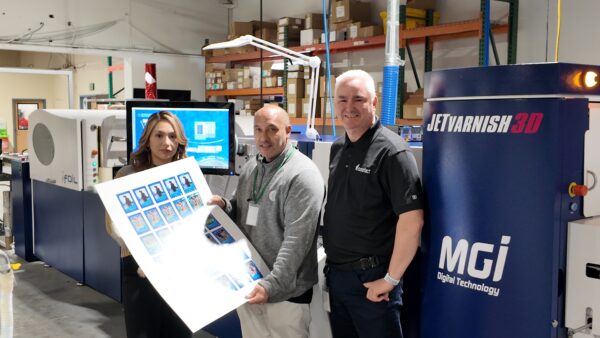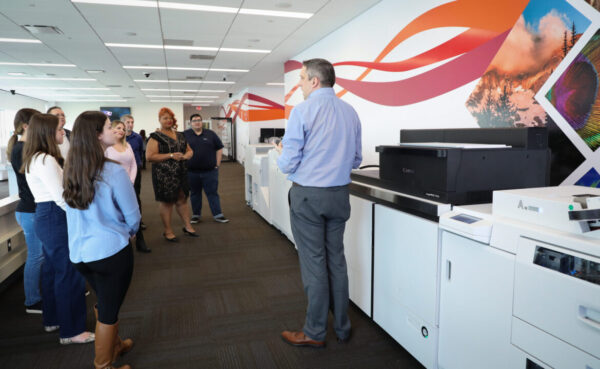Three visionary and accomplished business technology executives drive constant change and propel their companies forward.
Video: Click here to go on set and behind the scenes of our 2017 Women Influencers issue cover and cover story photo shoot in New York City with this month’s featured executives. Listen to these accomplished and visionary game-changers as they share their paths to success, infused with advice for both women and men.
 Imagine sitting down to an executive meeting, having years of valuable industry knowledge and experience, and being able to spark innovation and collaboration across multimillion””multibillion””dollar companies. This is every entrepreneur’s dream, and this year’s Women Influencers fill this exact role at each of their respective companies.
Imagine sitting down to an executive meeting, having years of valuable industry knowledge and experience, and being able to spark innovation and collaboration across multimillion””multibillion””dollar companies. This is every entrepreneur’s dream, and this year’s Women Influencers fill this exact role at each of their respective companies.
Canon’s Valerie Belli, PSIGEN Software’s Victoria Hensley, and Konica Minolta’s Ekta Sahasi have set ideas ablaze throughout their entire careers and continue to do so, propelling their companies forward and rising to the top echelons of their professions with their knowledge, business savvy, and sheer commitment to success.
VALERIE BELLI | VP, Enterprise Managed Services Division, Canon Solutions America, Inc.
Valerie Belli, vice president of the Enterprise Managed Services Division at Canon Solutions America, Inc., has always believed in thinking big. Growing up in an entrepreneurial family, Belli spent much of her childhood work-shopping business ideas at the kitchen table. From selling paintings in her parents’ antique shop at the age of nine to figuring out how to upgrade horse-riding saddles from an English saddle to an Italian jumping saddle on her family’s farm, she began learning early on how to make a deal.
“I was brought up in an environment of “˜you can,'” said Belli. “I was lucky.”
Belli’s can-do attitude has driven her throughout her multi-decade career, whether it was selling color copiers, and services (called Facilities Management in those days) for Xerox in the 1970s, starting Pandick Technologies as one of its founders in the 1980s (and subsequently selling the company to Pitney Bowes for $100 million), or helping Canon gain entry into the on-site services business, which she began doing in the late 1990s. By relying on strong business instincts she has sown throughout her career, she emphasizes profitability and balancing growth with efficiency.
In Belli’s current role at Canon Solutions America, she is charged with leading the design, implementation, and management of services that support essential business functions of enterprise organizations across multiple verticals. She oversees the work of more than 800 Canon Solutions America employees nationwide.
She works hand-in-hand with large, complex international organizations under $50 to $70 million multiyear contracts to improve document workflows. Her primary emphasis is delivering what’s promised to Canon’s clients by executing on uniquely developed plans. Her team creates workflow designs that are specific to each client. Then, she allocates a team of people””off or on the client’s premises, depending on the client’s needs””who make Canon’s designs come to life and pairs the appropriate technology and tools to allow the design to function.
“Our customers want us to be on the edge of technology and bring them to the edge because they don’t know how to do it,” said Belli. “We’re radical in that we’re sort of minimalist. We want to take clients and move them down as it relates to the amount of technology they have, but have the correct environment so they can move their information around.”
In order to achieve the level of success Belli now has and continues to maintain, she specifically surrounds herself with energetic, imaginative, radical thinkers. Early on in her career, as she was managing her first teams, Belli initially hired mostly married women in order to counter the male-dominated environment in the workplace. She wanted to propel their careers to help them pull in higher salaries than their husbands.
“When you think about it, that was just a terrible position to take,” said Belli. “One day, I finally sat back and really thought about it. I realized that I was participating in the problem, except I was coming at it from a female position and perspective. I realized there was a lot of talent out there, and you can’t look at talent through sex or color. You have to be wide open to all the talent so that you can select the best. When you’re only looking at just male or just female, you’re only looking at half the possibilities.”
Today, when she is advising her team leaders in the area of hiring talent, Belli directs them to look out her Manhattan office window.
“I tell them, “˜I want your team to look like the street,'” said Belli. “I think that it’s important to have that perspective. You have to look like your environment and society. You can’t be biased or you’ll miss out on the possibilities.”
While Belli confirms the industry remains very male-oriented, she says the biggest change is among today’s current and target customer landscape. When it comes right down to decision-making scenarios in sales, there are simply more women sitting at the other side of the table with substantial input into the decision-making process with vendors.
“I like to say that women count, as in 1-2-3,” said Belli. “Simply put, women are counting the women on the other side of the table. If your company doesn’t have women, that counts against you because your clients are very diverse, and they are going to take that into account when considering you.”
As important as increasing diversity has become at companies, Belli cautions that women can’t solely hang their destinies on being female. She strongly advocates for all employees””male and female””to find what they are ultimately great at and do it as well as they possibly can, making every effort to be the best in that area.
“Just be amazing,” said Belli. “It’s the thing that always wins. If you’re amazing, even the staunchest sexist is going to notice that and you’re going to be moved through the organization in a positive way.”
One Canon in Practice
In July 2016, Canon rolled out its “One Canon” business strategy that aims to break down internal company barriers to allow its clients to access all of Canon’s products and services to overcome business hurdles and innovate in today’s competitive business environment. It’s hard to imagine that anyone could possibly embody this strategy more than Valerie Belli.
Led by a potent combination of Belli’s client-driven planning and Canon Solution America’s offerings, the company won its contract with the University of Notre Dame in South Bend, Indiana. For many years, the school had worked with another provider, however, changing circumstances led them to seek out an alternate vendor and begin interviewing suitors. Notre Dame called Canon Solutions America in, having heard of the positive changes the company had been making at other universities.
Belli prides herself on minimizing the amount of technology, while maximizing the functionality of the technology placed with the client. Even though its costs were higher than other competitors for this piece of business, Canon Solutions America won the contract. Belli’s team came in and began designing a workflow plan to suit the university’s needs, as she had committed to do. But, she didn’t stop there.
“We got them in a good groove and then, we started introducing them to other Canon entities,” said Belli. “We brought in the integrated services group, the camera people, the projector people””all these things that have nothing to do with my business but would be really valuable for the university to know them and understand the other things that Canon does.”
Belli spent hours reviewing Canon’s capabilities across the company. As a direct result of her team’s efforts, Notre Dame entered into another Canon contract for broadcast lenses and movie-making equipment. While Belli isn’t compensated on business she drums up for other groups within Canon, she still reaps the rewards.
“The relationship we have with Notre Dame now is much grander, richer, and deeper,” said Belli. And this is exactly what Canon””and Belli””is always hoping to achieve with its clients.
* * * * *
VICTORIA HENSLEY | COO | PSIGEN Software, Inc.
For the majority of her multi-faceted career, PSIGEN Software, Inc.’s Chief Operating Officer Victoria Hensley has been the only woman in the room. When she attended the University of Southern Mississippi, where she graduated with degrees in both computer science and math with a concentration on physics, only less than 10% of the university’s female student body were enrolled in the computer science program, even though women comprised more than half the school’s student body at the time
“I was used to working with all men,” said Hensley. “I’ve never viewed myself as female in a male-dominated society, even though that is the reality. I view myself as a person with these qualities, talents, and experience.”
For a COO in the workplace technology industry, Hensley brings a unique background to the overall landscape. She’s worked for NASA, where she developed software for several orbiting satellites as an engineer. (Yes, Hensley actually was a rocket scientist.) While working at NASA, one of her primary projects was working with upper atmosphere research satellites (UARs) that measured the ozone layer, enabling researchers to monitor the hole in the ozone over the Antarctic region, as well as the impact of reducing the use of aerosol and hydrofluorocarbons on the atmosphere.
“I was brought up to think that I was no lesser than a man and no greater than a man,” said Hensley. “We are all equal, just different. I have always had that mentality that I can do whatever it is that I set my hands to. If I wanted to become a rocket scientist, it didn’t occur to me that I couldn’t.”
Hensley also worked for Maryland-based ARINC, which supplies airline communications globally. It was at this company that Hensley’s experience shifted from software development to focusing on quality assurance.
Despite the highly competitive atmosphere of her educational and professional environments, Hensley worked hard, paid her dues, and continuously strived to excel and add skills to her expanding toolbox. Yet, some of the most important skills she acquired came from the seven years she took to stay at home in order to raise her children.
During this time, Hensley became involved in many school-related activities, including participating in the PTA, raising money for various charities, and organizing large events. She also joined the Pampered Chef team, which employs consultants””most of which are women and mothers””to sell kitchen-related tools. With Pampered Chef, Hensley witnessed firsthand the benefits of a more cooperative, team-based mentality that was still competitive and based on achieving specific goals.
“The culture they bred wasn’t one of cut-throat competition,” said Hensley. “It was more about helping each other in a team environment to be the best we can be. We were encouraged to share tips and ideas that worked in our selling so that we could all be successful.”
When Hensley rejoined the full-time workforce after her seven-year hiatus, she brought all of her degrees and highly skilled, applicable work experience, including tools she added while being a stay-at-home mom.
Upon re-entry, she was able to command competitive compensation in line with what she would have been making had she remained in the workforce. The biggest hurdle was catching up on the evolving technology.
“I had missed the whole transition from DOS to Windows,” said Hensley. “I really had to work hard to close the seven-year technology gap, but I was never admonished or looked down upon for staying home. I was hired to do a particular job and I had the qualifications and tools to get that job done.”

STYLE AND SUBSTANCE (from left to right): Hensley, Belli, and Sahasi wear a limited edition silk scarf conceived of, designed, and styled by The Cannata Report’s own Carol Cannata and made by EFI Reggiani in Italy.
PSIGEN President Glenn Johnson convinced her to join the company as COO in 2014. Hensley’s technical, process management, and development skills, among others, that she had mastered throughout her career have enabled her successful contributions to the company.
“I loved the analysis of the process, evaluating how we were going to do it efficiently and effectively, how we could meet the needs of the customer and improve our productivity and profitability,” said Hensley.
At PSIGEN, Hensley oversees both the engineering and marketing segments of the company. The engineering segments include the development, quality assurance, technical support and IT, human resources, and corporate support teams. Hensley’s marketing role encompasses both external relationships (such as those with members of the press and a marketing agency) and internal marketing, which includes traditional marketing, website and digital platform development, corporate branding, and product user interface (UI) design. To maximize effectiveness across each of these responsibilities, Hensley has a sharp focus on process and structure.
“I have a natural tendency to teach, train, mentor, and help inspire the acquisition of knowledge, which personally helps me lead,” said Hensley.
With PSIGEN’s flat, team-oriented reporting structure, even managers are individual contributors. Hensley has been able to institute processes throughout the company that encourage open and efficient communication across and between all employees, as well as bringing transparency of knowledge to enable PSIGEN’s workers to access the tools they need for optimal productivity and success. This proven internal company strategy has led to innovation.
For example, PSIGEN’s leaders throughout the company can directly work with software developers to share ideas, opportunities or needs, rather than funneling them through Hensley herself or any management levels in between. The developer then communicates directly back up the management chain to keep all PSIGEN employees in the loop while moving forward quickly and efficiently.
“I’ve implemented practices to enable people in our company to move as one, as opposed to a big, bureaucratic ship,” said Hensley. “As we grow, we’re still able to maintain a nimbleness that plays a significant role in our success.”
You Don’t Have to Be a Rocket Scientist
PSIGEN’s products were developed based on the philosophy that its customers don’t have to be rocket scientists or have a programmer on site to implement and use the company’s technology and tools. PSIGEN’s goal is for customers to have ease of use with a powerful and diverse product in their hands.
With that goal in mind, in January 2017, PSIGEN acquired Cabinet Document Management Solutions, a content management, workflow, and business process automation solution provider. This acquisition gave PSIGEN access to Cabinet’s cloud-based document management product, which is the on-ramp for PSIGEN to implement products and ideas it has wanted to offer to its clients.
As PSIGEN prepares to roll out its PSIsafe and PSIsafe Cloud in early August, the company believes these products are perfectly suited for the SMB space. It has a term-based model and it is subscription-based.
As the company has done with PSIcapture, the focus is on integrating PSIsafe with other systems, including Salesforce and Redtail. A company may already have other systems in place, but PSIGEN’s goal is to work seamlessly and in tandem with those systems, rather than replacing them.
“We’ll work with the other systems to make them all work together,” said Hensley. “We’re a team player. We like that partner relationship.”
Stay tuned for more information on PSIsafe’s rollout later this year.
* * * * *
EKTA SAHASI | VP, Business Innovation Center | Konica Minolta, Inc.
One of the main areas of focus for Konica Minolta’s Business Innovation Center (BIC) is the “Workplace of the Future,” which looks to integrate existing solutions with cutting-edge technologies being developed in Silicon Valley. This effort is pinned to the fact that today’s workplace comprises five generations of employees from baby boomers to millennials and everyone in between.
“The needs and habits of these people are radically different,” said Sahasi. “What they are accustomed to and how they get their work done is very different. The idea of the Workplace of the Future is to look at how work gets done. It’s not about where the work is getting done, but how people are connecting and collaborating.”
In examining small- to medium-size businesses across numerous verticals from manufacturing to office equipment, gaining that understanding of how work is accomplished today and anticipating how people will communicate and collaborate in the future is essential in transforming the workplace of the future.
Through this overall effort, Konica Minolta has been able to bring together a plethora of technologies that fit the front, mid, and back office ““ and that facilitate the experience from the moment visitors enter into an office with a keen and specific awareness of the technology they interact with, to navigating them to the mid-office and providing efficient and effective tools and solutions to help facilitate how they get their work done with a priority on making information available at their fingertips in real time. Here, Konica Minolta is seeing more solutions that are artificial intelligence-and augmented reality-based.
“We have suites of technologies that facilitate employees having what they need with any device they’re going to use in that space where they’re going to use it,” said Sahasi.
In the back office, Konica Minolta is focusing on cloud devices around security. For example, Sahasi spoke of robots that are trolling facility perimeters or monitoring the physical security of an enterprise’s people or structure(s) and flagging certain events that should or should not be happening.
“These are just some examples of how we look at the transformation of the workplace of the future from the various perspectives of all the different actors in the workplace,” said Sahasi. “We can then assemble a portfolio of solutions that enhance their experience from when they start interacting with an enterprise to the security aspects from a back-office perspective.”
As part of Konica Minolta’s “Workplace of the Future” portfolio, the company rolled out a cloud-based virtual care-management solution, powered by SnapMD. The HIPPA and HITECH-compliant platform links doctors, patients, and care teams using secure live video, audio, and text messaging. With SnapMD as its partner, Konica Minolta is able improve communication, access, and convenience across the medical environment, facilitating care and reducing urgent-care or emergency-room visits.
With a sharp focus on problem-solving, Konica Minolta’s strategic partnerships with companies like SnapMD certainly ensure its place in the future.

FANTASTIC FOUR (From left to right): Valerie Belli, Ekta Sahasi, Carol Cannata, and Victoria Hensley, photographed by Jean-Bernard Villareal at Canoe Studios in New York City, June 20, 2017






